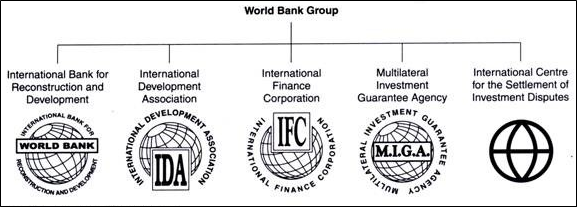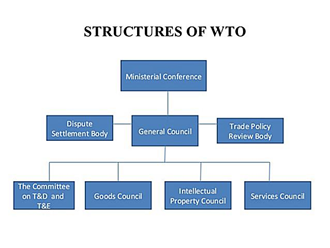
The World Trade Organization (WTO) is an international organization established in 1995 to regulate and facilitate international trade among member countries. It aims to create a fair and open trading system by enforcing trade agreements, resolving disputes, and promoting free trade. It ensures that trade flows smoothly, predictably, and freely across nations.
Roles of WTO
1. Trade Negotiations: Facilitating multilateral trade negotiations to reduce tariffs and other trade barriers.
2. Dispute Resolution: Providing a structured process for resolving trade disputes between member countries, ensuring adherence to agreed-upon rules.
3. Monitoring and Enforcement: Overseeing the implementation of trade agreements and ensuring compliance through regular monitoring and transparency.
4. Capacity Building: Assisting developing countries in trade policy issues, implementation, and negotiation through technical assistance and training programs.
Various Agreement under WTO
The World Trade Organization (WTO) encompasses various agreements aimed at facilitating international trade and ensuring fair practices. These agreements collectively aim to create a predictable and transparent trading environment, fostering global economic growth. Key agreements include:
-
- General Agreement on Tariffs and Trade (GATT): Focuses on reducing tariffs and other trade barriers for goods.
- General Agreement on Trade in Services (GATS): Deals with the liberalization of trade in services, ensuring fair treatment and market access.
- Trade-Related Aspects of Intellectual Property Rights (TRIPS): Establishes minimum standards for intellectual property protection and enforcement.
- Agreement on Agriculture (AoA): Promotes fair agricultural trade by addressing market access, domestic support, and export subsidies.
- Agreement on Technical Barriers to Trade (TBT): Ensures that technical regulations and standards do not create unnecessary obstacles to trade.
- Sanitary and Phytosanitary Measures (SPS): Protects human, animal, and plant health without unjustifiably restricting trade.
- Agreement on Trade-Related Investment Measures (TRIMs): Restricts investment measures that negatively affect trade.
- Anti-Dumping Agreement: Addresses the regulation of anti-dumping measures to prevent unfair pricing practices.
Subsidies
Consumer subsidies: They involve buying agricultural produce at market price and selling it at a loss to people, are generally not challenged at the WTO as they are closer to being a sort of welfare scheme.
Producer subsidies: They tend to be more controversial and involve giving financial support to farmers and agribusinesses. There are many types of producer subsidy, most of which fall into one of two categories:
a) Production-linked subsidies involve the state providing financial support based on the quantity of agricultural products produced, often by guaranteeing high prices for certain crops. Critics argue that this can lead to overproduction, creating surplus stocks. While some governments claim these stockpiles enhance food security, critics caution about the potential for mismanagement and abuse, citing the example of India’s National Food Security Act.
b) Non-production linked subsidies are not tied to specific farming quantities. Farmers receive cash irrespective of their agricultural output, even if they leave land fallow. Many subsidies under the EU’s Common Agricultural Policy and most US subsidies fall into this category, often benefiting wealthy landowners. Despite some being linked to environmental protection, these subsidies are criticized for essentially providing cash to affluent landowners for minimal effort. Notably, the WTO primarily restricts production-linked subsidies, allowing wealthy nations to heavily utilize non-production linked subsidies without significant limitations.
Agreement on Agriculture (AoA)
The Agreement on Agriculture (AoA) under the World Trade Organization (WTO) was established to create a fair and market-oriented agricultural trading system. It is a pivotal part of the Uruguay Round negotiations, which concluded in 1994.
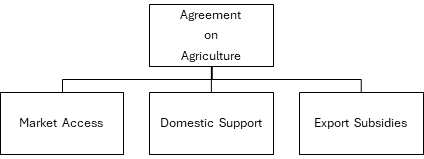
The AoA aims to enhance the agricultural sector’s competitiveness and sustainability globally while addressing the needs of developing countries by allowing them special and differential treatment. This agreement is crucial for balancing the interests of different countries and promoting fairer agricultural trade practices. The AoA focuses on three main pillars: market access, domestic support, and export subsidies.
1. Market Access: This involves the conversion of non-tariff barriers into tariffs (a process known as “tariffication”) and the reduction of tariffs over time. The aim is to open up agricultural markets and reduce the barriers to trade.
2. Domestic Support: The AoA classifies domestic subsidies into “boxes” (Amber, Blue, and Green) based on their impact on trade. The Amber Box contains measures considered to distort production and trade and are subject to reduction commitments. The Blue Box includes subsidies that are tied to programs limiting production, and the Green Box comprises subsidies that cause minimal distortion and are exempt from reduction commitments.
3. Export Subsidies: This pillar mandates the reduction of subsidies provided to agricultural exports. The goal is to eliminate unfair competition arising from the use of such subsidies.
Other Important terms (WTO)
-
- De Minimis: De minimis refers to the maximum allowable subsidy limit set by the WTO for its member countries. Developing nations are typically limited to 10% of the value of their agricultural output in 1988 prices, while rich countries face a 5% limit, often with negotiated exceptions.
- Stockpiling: Stockpiling is the accumulation of excess production, occurring when countries purchase products from farmers at a fixed, often above-market price. This practice serves food security goals or aims to boost farmers’ income.
- Green Box subsidies: These are measures not subject to WTO limits as they are deemed not to distort agricultural trade. However, some argue that these subsidies do impact international trade, while governments in the global south advocate for categorizing subsidies aimed at development-related goals, like reducing malnutrition, as green box.

-
- Amber Box subsidies: These are considered to distort international trade and must be reduced. These subsidies are often linked to production, such as price guarantees. A group of 30 primarily affluent countries is permitted to maintain higher levels of these subsidies, a situation criticized by campaigners and developing nations as unjust.
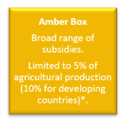
-
- Blue Box subsidies: Blue Box subsidies aim to provide support to farmers without excessively distorting international trade. Unlike more trade-distorting Amber Box subsidies, Blue Box payments are tied to production but are designed to limit it. These subsidies have conditions to prevent unlimited production expansion, striking a balance between supporting agriculture and minimizing trade distortion.
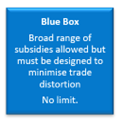
WTO and India
The World Trade Organization (WTO) stockholding norms and the Peace Clause are significant in the context of India’s agricultural policies, especially regarding food security.
Stockholding Norms: WTO rules under the Agreement on Agriculture (AoA) limit the amount of public stockholding for food security purposes. Countries can purchase food at administered prices but must ensure that these subsidies do not distort trade. The value of food subsidies is calculated based on a reference price set in 1986-88, often criticized as outdated and not reflecting current prices. (Refer to De Minimis point)
Peace Clause: At the 2013 Bali Ministerial Conference, the Peace Clause was introduced as a temporary measure to protect developing countries like India from being challenged under WTO dispute settlement mechanisms for breaching stockholding limits. This clause is valid until a permanent solution is negotiated.
India’s Perspective: India has a substantial public stockholding program to ensure food security for its vast population, including schemes like the Public Distribution System (PDS). India argues that the existing WTO norms are unfair and do not accommodate the needs of developing countries. The Peace Clause has provided temporary relief, allowing India to continue its food security programs without facing legal challenges. However, India continues to advocate for a permanent solution that recognizes the importance of food security and supports the right of developing nations to subsidize food for their populations without facing punitive measures.
13th WTO Ministerial Conference (MC 13: Abu Dhabi), 2024
The WTO Ministerial Conference is the highest decision-making body of the WTO and convenes every two years.
The 13th session was particularly crucial due to the global economic uncertainties, post-pandemic recovery, climate challenges, and digital transformation in trade.
The conference was aimed at addressing the WTO reform agenda, ongoing negotiations, and facilitating inclusive trade policies.
Key Agendas and Issues
-
- A significant focus was on institutional reforms to make the WTO more responsive and effective in global trade governance.
- Restoration of the Appellate Body to resolve trade disputes.
- Streamlining the WTO’s negotiating function to ensure more transparency and efficiency in decision-making.
Agriculture Negotiations
-
- Subsidies and market access for agricultural products.
- Food security concerns, especially after disruptions in supply chains due to geopolitical conflicts.
- Ensuring special and differential treatment for developing countries.
Other Negotiations
-
- Discussions were held on evolving global trade in the digital era, focusing on:
- Regulation of e-commerce under a multilateral framework.
- Data localisation, privacy issues, and cross-border data flows.
- The role of trade in combating climate change was emphasized with discussions around:
- Reducing tariffs on environmentally friendly goods and services to promote sustainable development.
Fishery Subsidies Agreement: Continued focus on finalizing the agreement on fishery subsidies to prevent overfishing and ensure sustainable fishing practices.
Outcomes of the Conference
-
- Appellate Body Reform: Members agreed on a roadmap to restore the Appellate Body by 2025. The U.S. showed willingness to discuss solutions, marking a breakthrough in the deadlock.
- Agriculture Progress: A consensus was reached to continue negotiations on key agricultural issues, including reducing trade-distorting subsidies and enhancing market access for developing countries.
- Interim Agreements on Digital Trade: Some progress was made on regulating e-commerce, though member countries had varying stances on data privacy and digital taxation. The conference emphasized the need for further discussions on a multilateral digital trade framework.
- Climate Trade Policies: Countries endorsed a framework to promote trade in environmental goods and services and agreed to reduce trade barriers on sustainable technologies.
- Fishery Subsidies: Although a final agreement was not reached, significant strides were made, and members agreed to aim for a conclusive deal by the next ministerial.
India’s Position and Contributions
-
-
- Agriculture: India strongly advocated for protecting the interests of small farmers, emphasizing the need for a permanent solution on Public Stockholding for food security.
- Digital Trade: India took a cautious approach, pushing for data sovereignty and opposing blanket rules on data localisation.
- Fisheries: India pushed for exemptions for developing countries in the fisheries agreement, arguing that small-scale and artisanal fishers should be protected from global subsidy rules.
-

